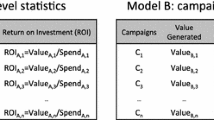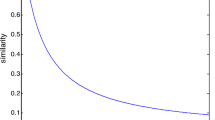Abstract
For branding campaigns, the demand-side platforms (DSPs) in real-time bidding (RTB) usually need to win as many impressions as possible to inform most audiences about the product messages under constraints on budgets, campaign lifetimes and budget spending plans. In this paper, we propose a novel bidding strategy by introducing the concept of expected win rate. With the proposed expected win rate-based bidding strategy, the DSP can dynamically adjust the expected win rate for each incoming bid request based on factors such as the predicted number of bid requests in the near future, the remaining budget and the remaining lifetime of the campaign. The experimental results show that the proposed bidding strategy has a lower cost per thousand impressions and cost per clicks than existing pacing model-based bidding strategies for branding campaigns with the same budgets and budget spending plans.































Similar content being viewed by others
Notes
A display of an ad is called an impression.
Performing such actions is called a conversion.
The details of the real datasets, iPinYou and Tenmax, will be given in Sect. 5.1.
iPinYou dataset: http://data.computational-advertising.org/, Tenmax dataset: https://www.dropbox.com/s/2uxqvaagq9t7c2o/TenmaxData.tar.gz.
Tenmax: https://www.tenmax.io/en/.
Code: https://goo.gl/fknkyg.
Real-Time Bidding Protocol: https://developers.google.com/authorized-buyers/rtb/start.
References
Agarwal D, Chen B-C, Elango P, Wang X (2011) Click shaping to optimize multiple objectives. In: Proceedings of the 17th ACM SIGKDD, pp 132–140
Agarwal D, Ghosh S, Wei K, You S (2014) Budget pacing for targeted online advertisements at linkedin. In: Proceedings of the 20th ACM SIGKDD, pp 1613–1619
Balseiro SR, Feldman J, Mirrokni V, Muthukrishnan S (2014) Yield optimization of display advertising with ad exchange. Manag Sci 60(12):2886–2907
Cai H, Ren K, Zhang W, Malialis K, Wang J, Yu Y, Guo D (2017) Real-time bidding by reinforcement learning in display advertising. In: Proceedings of the 10th ACM WSDM, pp 661–670
Chapelle O (2014) Modeling delayed feedback in display advertising. In: Proceedings of the 20th ACM SIGKDD, pp 1097–1105
Chen Y, Berkhin P, Anderson B, Devanur NR (2011) Real-time bidding algorithms for performance-based display ad allocation. In: Proceedings of the 17th ACM SIGKDD, pp 1307–1315
Cheng H, Cantú-Paz E (2010) Personalized click prediction in sponsored search. In: Proceedings of the 3rd ACM WSDM, pp 351–360
Cui Y, Zhang R, Li W, Mao J (2011) Bid landscape forecasting in online ad exchange marketplace. In: Proceedings of the 17th ACM SIGKDD, pp 265–273
Geyik SC, Faleev S, Shen J, O’Donnell S, Kolay S (2016) Joint optimization of multiple performance metrics in online video advertising. In: Proceedings of the 22nd ACM SIGKDD, pp 471–480
Guo H, Tang R, Ye Y, Li Z, He X (2017) Deepfm: a factorization-machine based neural network for CTR prediction. In: Proceedings of the 26th IJCAI, pp 1725–1731
He X, Pan J, Jin O, Xu T, Liu B, Xu T, Shi Y, Atallah A, Herbrich R, Bowers S, Candela JQ (2014) Practical lessons from predicting clicks on ads at facebook. In: Proceedings of the 8th ADKDD, pp 5:1–5:9
Juan Y, Lefortier D, Chapelle O (2017) Field-aware factorization machines in a real-world online advertising system. In: Proceedings of the 26th ACM WWW companion, pp 680–688
Kalyanakrishnan S, Singh D, Kant R (2014) On building decision trees from large-scale data in applications of on-line advertising. In: Proceedings of the 23rd ACM CIKM, pp 669–678
Kaplan EL, Meier P (1958) Nonparametric estimation from incomplete observations. J Am Stat Assoc 53(282):457–481
Lai H-C, Shih W-Y, Huang J-L, Chen Y-C (2016) Predicting traffic of online advertising in real-time bidding systems from perspective of demand-side platforms. In: Proceedings of the 3rd BIGPMA
Lee K-C, Jalali A, Dasdan A (2013) Real time bid optimization with smooth budget delivery in online advertising. In: Proceedings of the 7th ADKDD, pp 1:1–1:9
Lee K-C, Orten B, Dasdan A, Li W (2012) Estimating conversion rate in display advertising from past performance data. In: Proceedings of the 18th ACM SIGKDD, pp 768–776
Li X, Guan D (2014) Programmatic buying bidding strategies with win rate and winning price estimation in real time mobile advertising. In: Proceedings of 18th PAKDD, pp 447–460
Lin C-C, Chuang K-T, Wu WC-H, Chen M-S (2016) Combining powers of two predictors in optimizing real-time bidding strategy under constrained budget. In: Proceedings of the 25th ACM CIKM, pp 2143–2148
Liu Q, Yu F, Wu S, Wang L (2015) A convolutional click prediction model. In: Proceedings of the 24th ACM CIKM, pp 1743–1746
McMahan HB, Holt G, Sculley D, Young M, Ebner D, Grady J, Nie L, Phillips T, Davydov E, Golovin D, Chikkerur S, Liu D, Wattenberg M, Hrafnkelsson AM, Boulos T, Kubica J (2013) Ad click prediction: a view from the trenches. In: Proceedings of the 19th ACM SIGKDD, pp 1222–1230
Menon AK, Chitrapura K-P, Garg S, Agarwal D, Kota N (2011) Response prediction using collaborative filtering with hierarchies and side-information. In: Proceedings of the 17th ACM SIGKDD, pp 141–149
Oentaryo RJ, Lim EP, Low J-W, Lo D, Finegold M (2014) Predicting response in mobile advertising with hierarchical importance-aware factorization machine. In: Proceedings of the 7th ACM WSDM, pp 123–132
Pan J, Xu J, Ruiz AL, Zhao W, Pan S, Sun Y, Lu Q (2018) Field-weighted factorization machines for click-through rate prediction in display advertising. In: Proceedings of the 27th ACM WWW, pp 1349–1357
Perlich C, Dalessandro B, Hook R, Stitelman O, Raeder T, Provost F (2012) Bid optimizing and inventory scoring in targeted online advertising. In: Proceedings of the 18th ACM SIGKDD, pp 804–812
Punjabi S, Bhatt P (2018) Robust factorization machines for user response prediction. In: Proceedings of the 27th ACM WWW, pp 669–678
Ren K, Zhang W, Chang K, Rong Y, Yu Y, Wang J (2018) Bidding machine: learning to bid for directly optimizing profits in display advertising. IEEE Trans Knowl Data Eng 30(4):645–659
Rosales R, Cheng H, Manavoglu E (2012) Post-click conversion modeling and analysis for non-guaranteed delivery display advertising. In: Proceedings of the 5th ACM WSDM, pp 293–302
Shan L, Lin L, Sun C, Wang X (2016) Predicting ad click-through rates via feature-based fully coupled interaction tensor factorization. Electron Commer Res Appl 16(C):30–42
Vasile F, Lefortier D (2016) Cost-sensitive learning for bidding in online advertising auctions. CoRR arXiv:1603.03713
Vickrey W (1961) Counterspeculation, auctions, and competitive sealed tenders. J Finance 16(1):8–37
Wang Y, Ren K, Zhang W, Wang J, Yu Y (2016) Functional bid landscape forecasting for display advertising. In: Machine learning and knowledge discovery in databases: European conference, pp 115–131
Wu D, Chen X, Yang X, Wang H, Tan Q, Zhang X, Gai K (2018a) Budget constrained bidding by model-free reinforcement learning in display advertising. In: Proceedings of the 27th ACM CIKM
Wu W, Yeh M-Y, Chen M-S (2018b) Deep censored learning of the winning price in the real time bidding. In: Proceedings of the 24th ACM SIGKDD, pp 2526–2535
Wu WC-H, Yeh M-Y, Chen M-S (2015) Predicting winning price in real time bidding with censored data. In: Proceedings of the 21st ACM SIGKDD, pp 1305–1314
Xu J, Lee K-C, Li W, Qi H, Lu Q (2015) Smart pacing for effective online ad campaign optimization. In: Proceedings of the 21st ACM SIGKDD, pp 2217–2226
Zhang W, Du T, Wang J (2016a) Deep learning over multi-field categorical data: A case study on user response prediction. CoRR arXiv:1601.02376
Zhang W, Wang J (2015) Statistical arbitrage mining for display advertising. In: Proceedings of the 21st ACM SIGKDD, pp 1465–1474
Zhang W, Yuan S, Wang J (2014a) Optimal real-time bidding for display advertising. In: Proceedings of the 20th ACM SIGKDD, pp 1077–1086
Zhang W, Yuan S, Wang J, Shen X (2014b) Real-time bidding benchmarking with ipinyou dataset. arXiv preprint arXiv:1407.7073
Zhang W, Zhou T, Wang J, Xu J (2016b) Bid-aware gradient descent for unbiased learning with censored data in display advertising. In: Proceedings of the 22nd ACM SIGKDD, pp 665–674
Zhu W-Y, Shih W-Y, Lee Y-H, Peng W-C, Huang J-L (2017) A gamma-based regression for winning price estimation in real-time bidding advertising. In: 2017 IEEE international conference on big data, pp 1610–1619
Acknowledgements
This work was supported in part by Ministry of Science and Technology, Taiwan, under contracts MOST 106-2221-E-009-152-MY3, MOST 106-3114-E-009-011 and MOST 107-2218-E-009-052.
Author information
Authors and Affiliations
Corresponding author
Additional information
Publisher's Note
Springer Nature remains neutral with regard to jurisdictional claims in published maps and institutional affiliations.
Appendices
Appendix A: EWR algorithm



Algorithm 1 shows the details of the proposed bidding strategy. In the off-line initialization, the DSPs can averagely allocate the total budget to each time slot, or based on some phenomena, such as request flow of each time slot, to assign different budgets to different time slots. As mentioned in Sect. 4.1, the pacing rate for each time slot, \(p\_r_t\), is set to the highest of the possible values to obtain the most opportunities to win impressions. In line 7, the request flow of the first time slot is predicted, and the flow prediction will continue updating to make a more precise prediction for the remaining time slots. Then, the bid function is established according to the historical bidding records (line 8), and the details of the bid function establishment are shown in Algorithm 3, where R represents the historical bidding records. In Algorithm 3, the optimized \(\beta \) can be obtained by stochastic gradient descent (SGD) or other online learning methods. From lines 12 to 15, the approximation models, \(\delta _3(\cdot , \cdot )\) and \(\delta '_4(\cdot )\), are also trained based on the historical winning bids.
In the online bidding, when a new bid request arrives, the algorithm checks whether the current time slot has expired (line 20). If the current time slot has not expired, the steps described in the next paragraph are performed to determine the bid price of the incoming bid request. Otherwise, a new time slot begins, and the following steps are executed before the bid price determination. First, the models of the request flow prediction and the bid function of the new time slot are updated by the bidding records of the previous time slot (lines 21 and 22). Then, from lines 24 to 30, the remaining budget and the difference between the bid price and the winning price are updated. Additionally, the request flow in the new time slot is predicted. Finally, the buffers to store the bidding records, such as the bidding results in the new time slot, are also reinitialized (lines 33 and 35) for collecting new bidding records.
In bid price determination, based on the features of the incoming bid request and the current remaining resources, the expected win rate for this bid request is calculated in line 36. The details of the expected win rate calculation are shown in Algorithm 2. To raise the expected win rate (Eq. 22), the CTR can be estimated according to the methods proposed in prior studies on performance prediction [5, 13, 17, 21, 28], and \(\alpha \) can be tuned based on historical data. With the expected win rate, the bid price is determined from lines 37 to 39, where \(\tau \) is a bid price threshold to prevent overspending the budget, as shown in Eq. (1). If the remaining budget is less than the bid price, the request will be directly dropped or bid with the lowest price allowed by the ad exchange. (An ad exchange may ask all DSPs to submit their bid prices with no less than a minimal bid price for all bid requests.) Lines 41 to 51 address the returned bidding result. If the bid strategy wins the bid request, the remaining budget should be updated by the returned winning price of bid request \(x_j\), \(WP_j\).
Appendix B: Validation results
Rights and permissions
About this article
Cite this article
Shih, WY., Huang, JL. An expected win rate-based real-time bidding strategy for branding campaigns on display advertising. Knowl Inf Syst 61, 1395–1430 (2019). https://doi.org/10.1007/s10115-019-01331-8
Received:
Revised:
Accepted:
Published:
Issue Date:
DOI: https://doi.org/10.1007/s10115-019-01331-8




